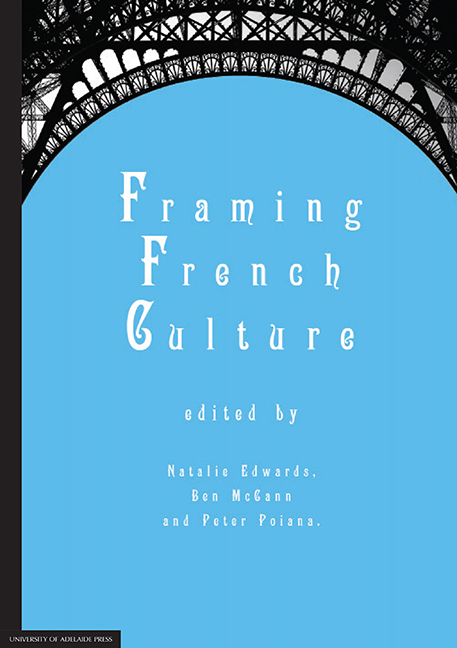Book contents
- Frontmatter
- Contents
- Introduction
- Part 1 Historical framings
- Part 2 Cultural icons and cinematic framings
- Part 3 Photographic framings
- 8 Annie Ernaux's phototextual archives: Ecrire la vie
- 9 The image of self-effacement: The revendication of the autonomous author in Marie NDiaye's Autoportrait en vert
- 10 Accumulating Algeria: Recurrent images in Pied-Noir visual works
- Part 4 Artistic framings
9 - The image of self-effacement: The revendication of the autonomous author in Marie NDiaye's Autoportrait en vert
from Part 3 - Photographic framings
Published online by Cambridge University Press: 05 February 2016
- Frontmatter
- Contents
- Introduction
- Part 1 Historical framings
- Part 2 Cultural icons and cinematic framings
- Part 3 Photographic framings
- 8 Annie Ernaux's phototextual archives: Ecrire la vie
- 9 The image of self-effacement: The revendication of the autonomous author in Marie NDiaye's Autoportrait en vert
- 10 Accumulating Algeria: Recurrent images in Pied-Noir visual works
- Part 4 Artistic framings
Summary
Michel Beaujour states his dissatisfaction with the term ‘autoportrait’ to encapsulate adequately literary endeavours at self-representation. The connection between self-portraiture and painting is evident, and the slippage of the term across mediums leads, in Beaujour's opinion, to deny the specificity of literary works. Yet, referring to works such as Michel de Montaigne's Essais, Michel Leiris's L'âge d'homme and Jean-Jacques Rousseau's Rêveries, Beaujour highlights its usefulness as a tool that distinguishes it from autobiographical texts for two fundamental reasons. First, self-portraiture insists upon an absence of continuity, thus defying any clearly arranged order of events that contribute to a personality created in narrative. Furthermore, the self-portraitist responds to time differently from the autobiographer, since s/he does not necessarily write a retrospective narrative; whereas the autobiographer is generally concerned with how s/he has become what s/he has — the scope of the self-portraitist is who s/he is now, in the present time of writing. Herein lies one of the main reasons for the derision of the self-portrait: it may be viewed as mere ‘scribbling’, an attempt to encapsulate the present self in words with no clear purpose or direction. As Beaujour resumes, the self-portrait ‘ne s'adresse à un éventuel lecteur qu'en tant que celui-ci est placé en position de tiers exclu. L'autoportrait s'adresse à lui-même’.
In contrast to autobiography, the self-portrait is relatively undertheorised, but Beaujour offers a partial definition, declining how the self-portrait
tente de constituer sa cohérence grâce à un système de rappels, de reprises, de superpositions ou de correspondances entre des éléments homologues et substituables, de telle sorte que sa principale apparence est celle du discontinu, de la juxtaposition anachronique, du montage, qui s'oppose à la syntagmatique d'une narration, fût-elle très brouillée, puisque le brouillage du récit invite toujours à en ‘construire’ la chronologie.
Moreover, the correlation between textual and visual elements — between a painter's self-portrait and a writer's — adds a further layer to a narrative self-portrait. Beaujour points to Leiris's and Montaigne's metaphors for painting in their work, showing their preoccupation with the visual genre and its impact upon their narrative. Yet, Beaujour argues, the writer's work departs from that of the painter since when s/he begins to write, s/he cannot render her/himself as though looking at a mirror, but is instead affected by the culture and the language in which s/he is immersed.
- Type
- Chapter
- Information
- Framing French Culture , pp. 193 - 208Publisher: The University of Adelaide PressPrint publication year: 2015



